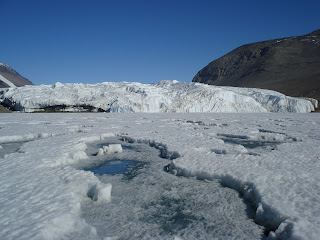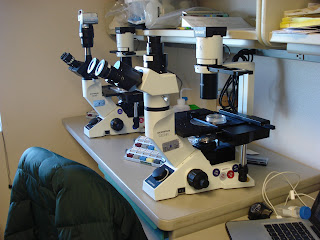I would like to apologize for all of the pictures. I have hundreds of pictures from yesterday alone and I picked only the very best!
We went to the south side of Lake Bonney yesterday to sample and apply experimental treatments to the final set of BEE plots. I plan to go into more detail about our sampling techniques in a later post and I've already talked about the specific treatments at the BEE plots in a previous post.
 |
| The BEE plots with the Taylor Glacier in the background |
Lake Bonney is still in Taylor Valley, which is the same valley I have been in for all of my field work. Of the three main lakes in Taylor Valley (Fryxell, Hoare, and Bonney), Lake Bonney is the farthest away from the ocean. It is a saline lake not because of influence from the ocean but because salts don't have a good way to escape. I was at the west end of the lake near where the edge of Taylor Glacier is at.
We had 3 hours of ground time and we were able to finish all of our work within an hour and 45 minutes, so we used the rest of our time to do some exploring! We walked to the edge of Lake Bonney because we needed to take a water sample for another researcher as a favor. The lake had a moat around it (the lake edges were melted) but we thought it might be worth it to test out the ice to see if we could walk on it. Sure enough, it supported us! The only part in question was the very edge of the ice where it was obviously melting away, but we found a rock jutting out a little bit and we were able to step right onto the ice. It gave a slight cracking noise but didn't break! (I let someone heavier than me go first! Smart thinking, huh?)
 |
| Deciding if we wanted to go out on the lake ice. That's the rock we ended up using! |
The ice is safe to walk on in the thick areas. In fact, there is a shelter on the ice permanently since it never thaws. You can easily see the thin parts while you're walking on it.
 |
| An example of some weak areas in the lake ice. Taylor Glacier in the background |
We walked over to take pictures of Blood Falls at the edge of Taylor Glacier, which is famous enough to
have its own Wikipedia entry. The color is due to iron oxides that emerge from a pool hidden inside the glacier. The color is not as bright right now as it can be (like if you compare my picture with Wikipedia's).
 |
| Taylor Glacier. There is actually a small waterfall at the base of the glacier if you look closely! It's easier to see when you can see the water moving |
 |
| Standing on Lake Bonney with Blood Falls of the Taylor Glacier in the background |
 |
| Blood Falls, Taylor Glacier |
 |
| Rhone Glacier with Lake Bonney in foreground |
After we were done, we walked back to the helipad to wait for the helicopter. A helipad at a site like this is just a flat spot with a collection of rocks arranged in a square with little flags marking it.
While we were out sampling, the PIs (Principal Investigators aka the professors who lead the project) were in Garwood Valley doing some reconnaissance work for a new experiment that they want to set up. The helicopter pilot wanted to save time by cramming all 7 of us passengers in the chopper with all of our gear (the Bell 212 has room for 8 passengers in the back) so we got an amazing scenic helicopter flight from Lake Bonney down to Garwood Valley. This whole area is almost entirely free from human interaction. Taylor Valley is built up a little bit with a few scattered huts, a handful of experiments, etc. but Garwood Valley and the area in between is not like that at all.
 |
| An example of one of the many amazing views from the helicopter window. This was when we were over the Kukri Hills |
 |
| A glacier with an amazingly circular moraine (the moraine is the earth that has been pushed in front of the glacier) |
 |
| Garwood Valley. Joyce Glacier in foreground |
 |
| Joyce Glacier. The valley is quite active hydrologically (meaning there's lots of water), making it interesting to study the soil ecology |
 |
| Garwood Glacier |
Well, that's about all I have to say about yesterday. It was an incredible trip and definitely a once-in-a-lifetime experience.














































